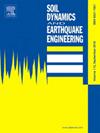Parameterized fragility-based uncertainty influence quantification and sensitivity analysis methodology: Concept, formulation, and application
IF 4.6
2区 工程技术
Q1 ENGINEERING, GEOLOGICAL
引用次数: 0
Abstract
Uncertainty modeling is a crucial issue in the seismic risk and resilience assessment of structures and infrastructures. Understanding and quantifying the impact of structural model parameter uncertainty (i.e., the epistemic uncertainty) on seismic fragility of structures are still open issues in the field of earthquake engineering. To this end, this study proposes a parameterized fragility-based methodology to quantify and rank the influence of multiple model parameter uncertainties on the seismic fragility result when their uncertainty is simultaneously involved. The concept and detailed procedure of this methodology is first introduced in this study. After that, the proposed methodology is applied to a case study bridge, i.e., unbonded laminated rubber bearing (ULRB) supported highway bridge retrofitted with transverse steel damper (TSD), to investigate how the uncertainty of the concerned model parameters affects the seismic fragility of the selected benchmark bridge when separately using the residual and peak displacements as engineering demand parameters (EDPs). The parameter sensitivity of fragility corresponding to these two EDPs is then quantified by a new proposed index and ranked using Tornado diagrams. In addition, the seismic fragility result when considering different sources of uncertainty is compared and discussed in this study through the parameterized fragility model. The result shows whether considering the uncertainty of model parameters has a more considerable influence on the fragility result when using the residual displacement as EDP as compared with using peak displacement as EDP. The sensitivity ranking of the parameters is affected by the damage level or the nonlinearity of the structural system. Regarding the residual and peak bearing displacements of ULRB-supported highway bridges, the friction coefficient is the most sensitive parameter.
基于参数的脆性不确定性影响量化和敏感性分析方法:概念、制定和应用
不确定性建模是结构和基础设施地震风险和抗震性评估中的一个关键问题。理解和量化结构模型参数不确定性(即认识不确定性)对结构抗震脆性的影响仍是地震工程领域的未决问题。为此,本研究提出了一种基于参数化脆性的方法,用于量化和排序同时涉及多个模型参数不确定性时对地震脆性结果的影响。本研究首先介绍了该方法的概念和详细步骤。然后,将所提出的方法应用于案例研究桥梁,即采用横向钢阻尼器(TSD)加装的无粘结层叠橡胶支座(ULRB)公路桥,研究在分别使用残余位移和峰值位移作为工程需求参数(EDP)时,相关模型参数的不确定性如何影响所选基准桥梁的地震脆性。与这两个 EDPs 相对应的脆性参数敏感性通过一个新提出的指数进行量化,并使用龙卷风图进行排序。此外,本研究还通过参数化脆性模型对考虑不同不确定性来源时的地震脆性结果进行了比较和讨论。结果表明,与使用峰值位移作为 EDP 相比,使用残余位移作为 EDP 时,考虑模型参数的不确定性对脆性结果的影响更大。参数的灵敏度排序受结构系统的破坏程度或非线性影响。就超限梁支承公路桥梁的残余位移和峰值支承位移而言,摩擦系数是最敏感的参数。
本文章由计算机程序翻译,如有差异,请以英文原文为准。
求助全文
约1分钟内获得全文
求助全文
来源期刊

Soil Dynamics and Earthquake Engineering
工程技术-地球科学综合
CiteScore
7.50
自引率
15.00%
发文量
446
审稿时长
8 months
期刊介绍:
The journal aims to encourage and enhance the role of mechanics and other disciplines as they relate to earthquake engineering by providing opportunities for the publication of the work of applied mathematicians, engineers and other applied scientists involved in solving problems closely related to the field of earthquake engineering and geotechnical earthquake engineering.
Emphasis is placed on new concepts and techniques, but case histories will also be published if they enhance the presentation and understanding of new technical concepts.
 求助内容:
求助内容: 应助结果提醒方式:
应助结果提醒方式:


